World
Tesla's Sporty, Two-Seater Robotaxi Design Puzzles Experts

World
China surrounds Taiwan in military exercise against independence
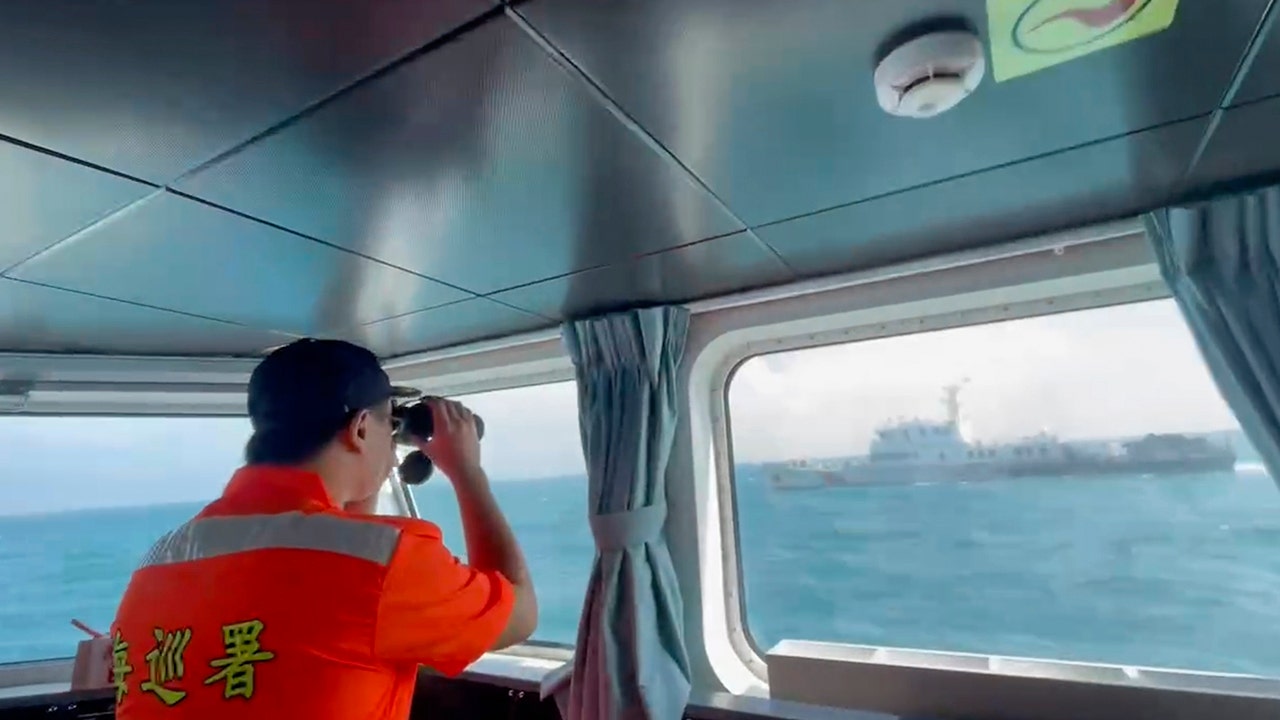
China launched a record-breaking number of military aircraft Monday in exercises surrounding Taiwan serving as a warning against independence, officials say.
Taiwan’s Ministry of National Defense says the 125 Chinese military aircraft are the most that it has counted in a single day. The Ministry added that 90 of the aircraft, including warplanes, helicopters and drones, were spotted within Taiwan’s air defense identification zone.
China’s Defense Ministry said the drills were a response to the Taiwanese president’s refusal to accept Beijing’s demand that self-governed Taiwan acknowledge itself as a part of the People’s Republic of China under the rule of the Communist Party.
The military operation comes four days after Taiwan celebrated the founding of its government on its National Day, with Taiwanese President Lai Ching-te saying in a speech that China has no right to represent Taiwan and declaring his commitment to “resist annexation or encroachment.”
CHINESE UNIVERSITY OF MICHIGAN STUDENTS CHARGED AFTER ALLEGEDLY SPYING ON MILITARY BASE
A China Coast Guard boat passes near the coast of Matsu islands of Taiwan on Monday, Oct. 14. (Taiwan Coast Guard/AP)
“The United States is seriously concerned by the People’s Liberation Army joint military drills in the Taiwan Strait and around Taiwan,” State Department Spokesperson Matthew Miller said in a statement. “The PRC response with military provocations to a routine annual speech is unwarranted and risks escalation.
“We call on the PRC to act with restraint and to avoid any further actions that may undermine peace and stability across the Taiwan Strait and in the broader region, which is essential to regional peace and prosperity and a matter of international concern,” he added. “We continue to monitor PRC activities and coordinate with allies and partners regarding our shared concerns.”
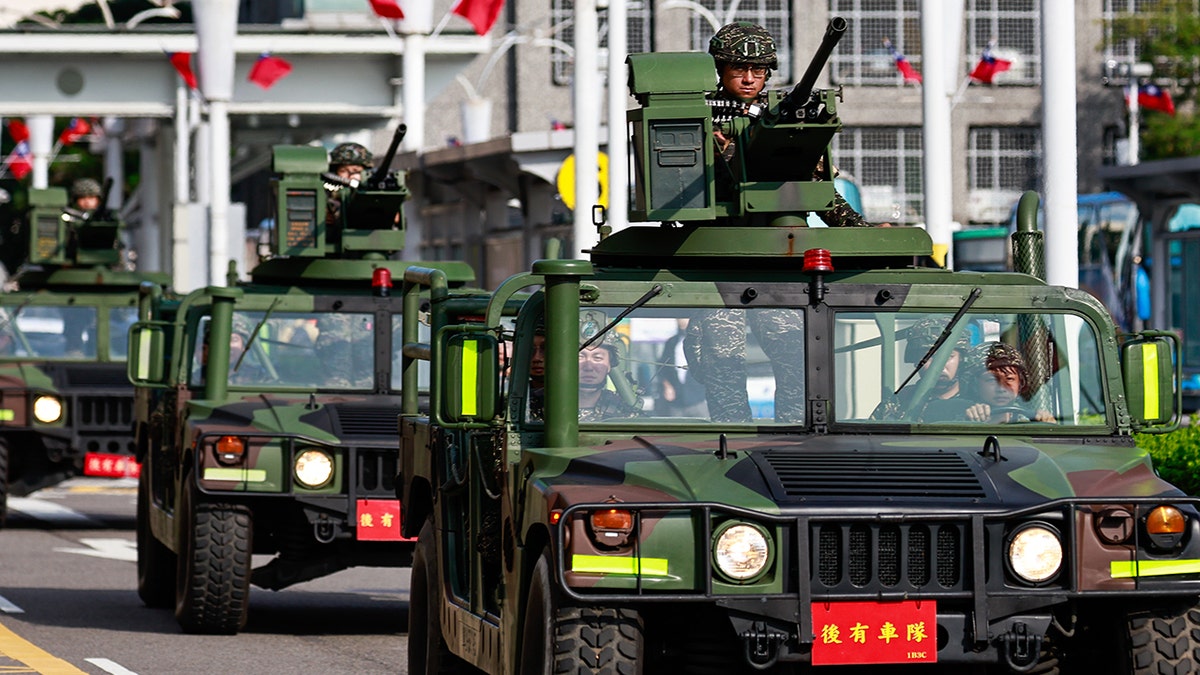
A procession of Taiwanese armed military vehicles patrols outside the Songshan Airport in Taipei, Taiwan during China’s military exercises encircling Taiwan on Monday, Oct. 14. (Daniel Ceng/Anadolu via Getty Images)
Chinese Foreign Ministry spokesperson Mao Ning slammed Taiwanese independence during a briefing last Friday, saying, “I would like to stress that ‘Taiwan independence’ is as incompatible with peace of the Taiwan Strait as fire with water.”
“The Lai Ching-te authorities’ attempt to reject reunification through the use of force is futile. No matter how many weapons they buy, they cannot stop the historical trend toward China’s reunification,” she also said.
TAIWANESE PEOPLE READY TO FIGHT AS CHINA RAMPS UP AGGRESSION, AMBASSADOR SAYS
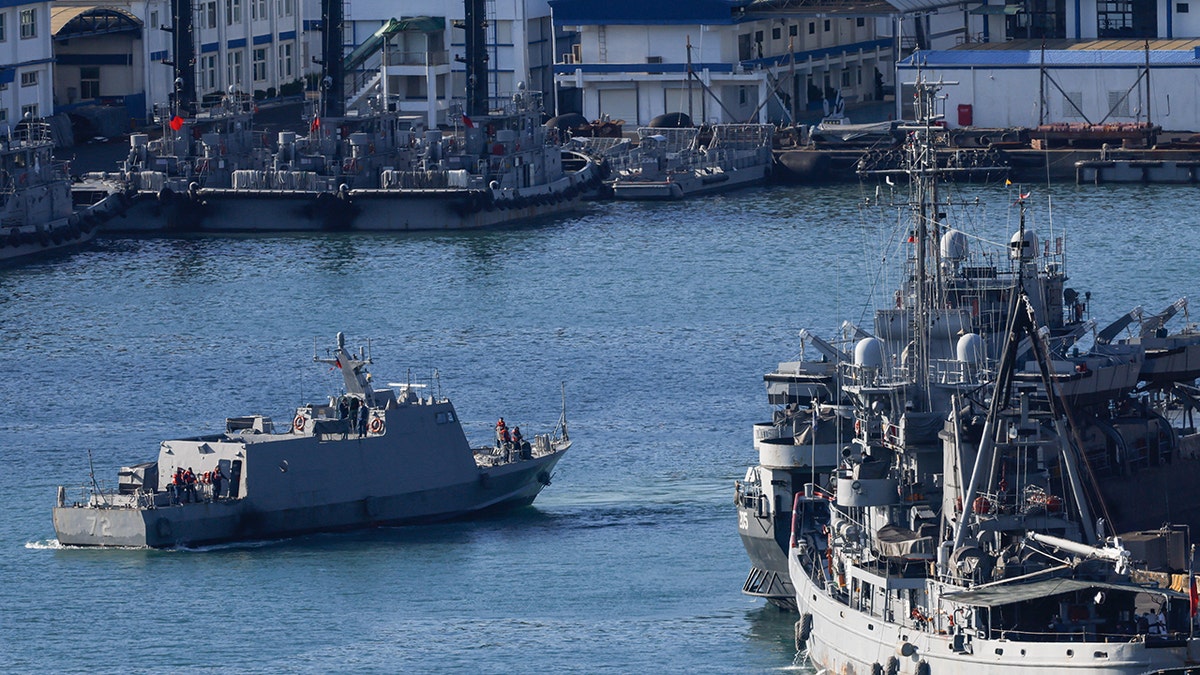
A Taiwanese navy Kuang Hua VI-class missile boat moves within the harbor of Keelung, Taiwan, on Monday, Oct. 14. (Reuters/Tyrone Siu)
A map aired on China’s state broadcaster CCTV showed six large blocks encircling Taiwan indicating where the military drills were being held, along with circles drawn around Taiwan’s outlying islands. China’s Defense Ministry has not said how long the drills will last.
China deployed its Liaoning aircraft carrier for the drills, and CCTV showed a J-15 fighter jet taking off from the deck of the carrier, though the exact location of the ship is unclear.
China’s People’s Liberation Army’s Eastern Theater Command spokesperson Senior Captain Li Xi said the navy, army air force and missile corps were all mobilized for the drills, which were an integrated operation, according to the Associated Press.
Taiwan’s Defense Ministry said it deployed warships to designated spots in the ocean to carry out surveillance and stand ready. It also deployed mobile missile and radar groups on land to track the vessels at sea.
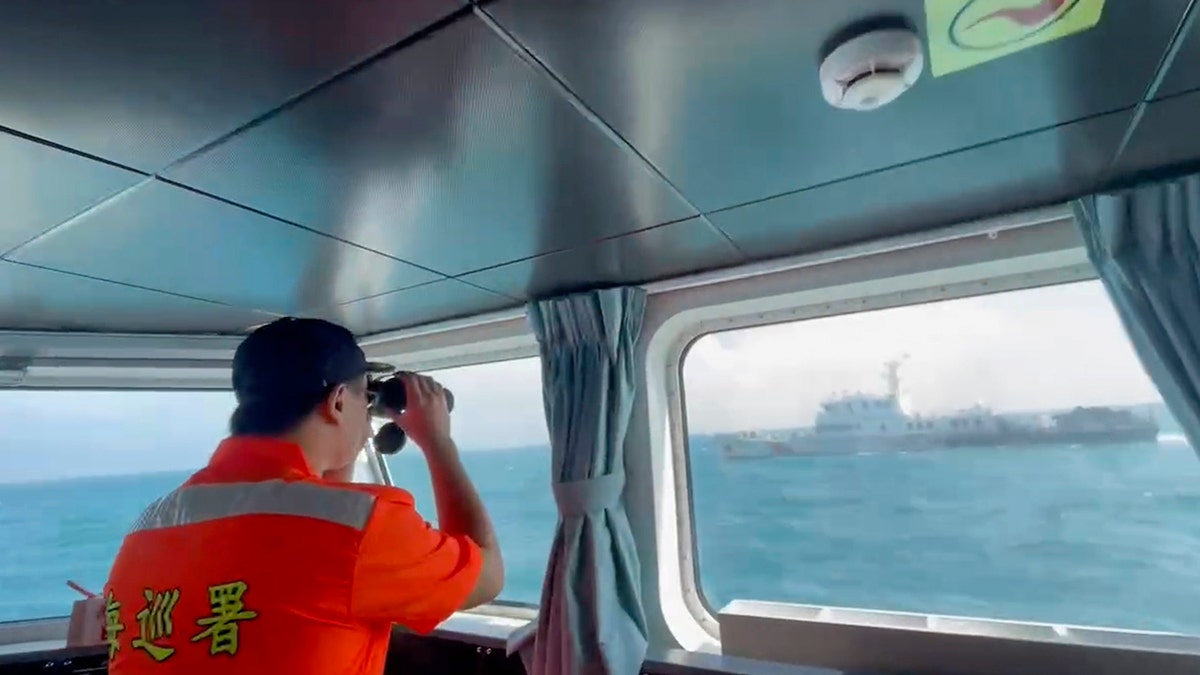
A member of the Taiwan Coast Guard monitors a China Coast Guard boat as it passes near the coast of the Matsu islands governed by Taiwan on Monday, Oct. 14. (Taiwan Coast Guard/AP)
“Our military will definitely deal with the threat from China appropriately,” Joseph Wu, secretary-general of Taiwan’s security council, said Monday at a forum in Taipei, according to the AP. “Threatening other countries with force violates the basic spirit of the United Nations Charter to resolve disputes through peaceful means.”
The Associated Press contributed to this report.
World
Suspending right to asylum goes against EU law, Brussels tells Warsaw
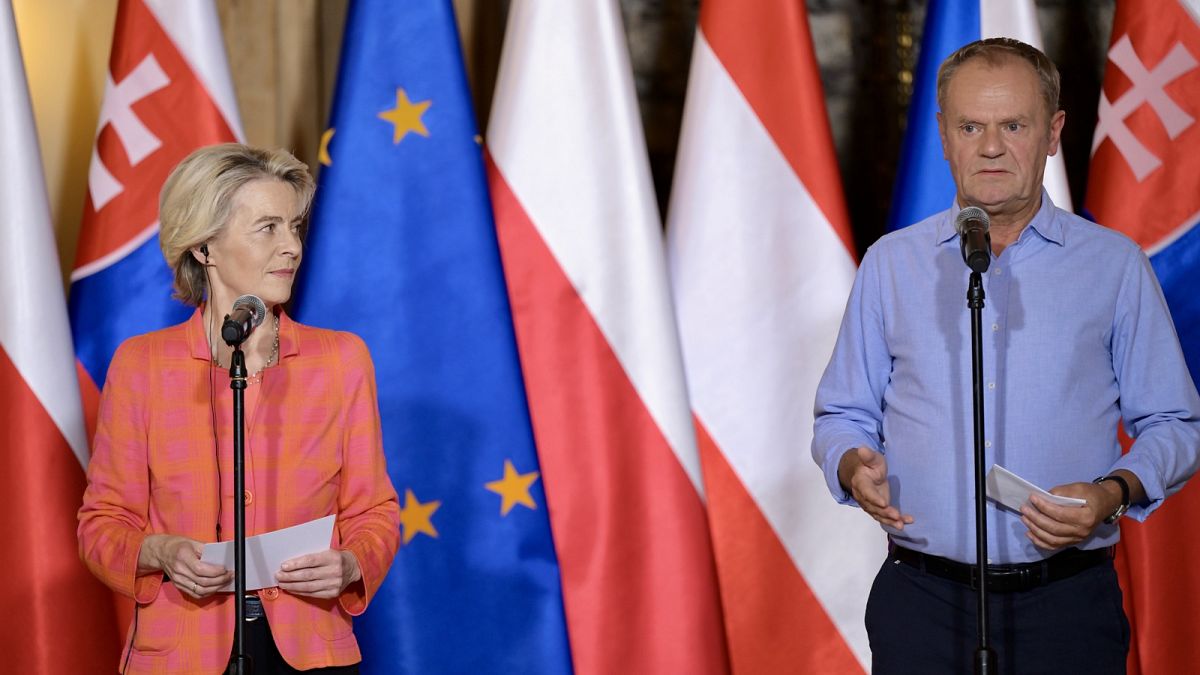
Donald Tusk’s plan to implement a “temporary territorial suspension of the right to asylum” has been met with disapproval in Brussels.
The European Commission has reminded Poland of its obligation under EU and international law to provide access to the asylum procedure under all circumstances, effectively disapproving Prime Minister Donald Tusk’s new strategy to institute a “temporary territorial suspension of the right to asylum”.
Tusk said his plan, which is scheduled to be officially unveiled on Tuesday, was necessary to combat the migration flows instrumentalised by Russia and Belarus, which Poland has experienced since August 2021. Border crossings have increased in recent weeks, without reaching the numbers seen at the peak of the crisis.
The prime minister’s announcement made immediate headlines, coming at a politically fraught time when European governments show increasing boldness in their attempts to curb irregular migration, testing the limits of well-established legal norms.
“It is important and imperative that the Union is protecting the external borders and, in particular, from Russia and Belarus (who are) undermining the security of the EU member states and of the Union as a whole,” a Commission spokesperson said on Monday.
“At the same time, member states have international and EU obligations, including the obligation to provide access to the asylum procedure.”
Countering hybrid attacks and ensuring asylum rights are not “mutually exclusive” tasks, the spokesperson added.
The right to asylum has long been recognised under international law, dating back to the 1951 Refugee Convention. It was later included in the EU’s Charter of Fundamental Rights, which has the same legal weight as the EU treaties.
The right does not ensure the application is automatically accepted: instead, it compels governments to accept asylum claims, analyse them with due diligence and issue a reasoned decision, with the possibility of appeal.
International law also establishes the principle of non-refoulement, which forbids authorities from deporting migrants to nations where they could face persecution, torture or any other form of ill-treatment.
In his remarks on Saturday, Tusk said he would demand “recognition in Europe” for his decision to establish a “temporary territorial suspension of the right to asylum.”
“We know very well how it is used by Lukashenko, Putin… by people smugglers, people traffickers, how this right to asylum is used exactly against the essence of the right to asylum,” he said speaking at a convention of his centrist Civic Platform.
“Poland must take back 100% control over who comes to Poland.”
Tusk’s policy echoes the emergency law that Finland introduced in July to fight against instrumentalised migration. If triggered, the law will allow border guards to “immediately” remove asylum seekers and refuse access to the asylum procedure. Legal experts and humanitarian organisations have warned the bill legalises pushbacks.
Warsaw says no to the Pact
Tusks’s speech, which observers have described as an electoral maneuver to contain the hard-right opposition, took aim at the New Pact on Migration and Asylum, the sweeping reform the bloc completed in May after almost four years of hard-fought negotiations.
Poland, like Hungary, voted against the five laws that make up the Pact. Their firm opposition hones in on a novel system of “mandatory solidarity” that will give countries three different options to manage asylum seekers: relocate a certain number, pay €20,000 for each applicant they refuse to take in, or finance operational support.
The Pact will enter into force in mid-2026. Before then, capitals are expected to put forward national plans to guarantee the correct implementation of the complex set of legislation. But according to Tusk, Poland will not be among the participants.
“We will not implement European ideas if we are sure that they threaten our security,” he said on Saturday.
In reaction, the Commission said the Pact, after being approved by the European Parliament and the Council, is “binding” for all 27 member states.
The reform features the Crisis Regulation to cope with sudden mass arrivals and instances of instrumentalisation, as the ones Poland and the Baltics have experienced. Under the regulation, countries will have additional time to register and examine asylum claims without letting applicants into national territory.
“Nevertheless, we still have maintained, as throughout (the process), the obligation to ensure access to asylum procedures,” the spokesperson noted.
Migration will be one of the most prominent topics – if not the most – during a summit of EU leaders on Thursday.
The last few months have seen a rapid succession of developments in migration policy, including Germany’s re-introduction of border controls, the Netherlands’ (rejected) request for an opt-out clause, and Hungary’s threat to bus migrants “free of charge” to Belgium in retaliation for an ECJ ruling.
Last week, a group of 17 European countries signed a document calling for a “paradigm shift” in the deportation of rejected asylum seekers. France’s new Interior Minister Bruno Retailleau said that “all innovative solutions must be used.”
In 2023, the EU detected 380,000 irregular border crossings and received about 1,140,000 claims for international protection. This means most asylum applications were filed by people who had arrived in the bloc via legal channels.
World
China’s ‘New Great Wall’ Casts a Shadow on Nepal

The Chinese fence traces a furrow in the Himalayas, its barbed wire and concrete ramparts separating Tibet from Nepal. Here, in one of the more isolated places on earth, China’s security cameras keep watch alongside armed sentries in guard towers.
High on the Tibetan Plateau, the Chinese have carved a 600-feet-long message on a hillside: “Long live the Chinese Communist Party,” inscribed in characters that can be read from orbit.
Just across the border, in Nepal’s Humla District, residents contend that along several points of this distant frontier, China is encroaching on Nepali territory.
Source: OpenStreetMap, ESRI
By Agnes Chang
The Nepalis have other complaints, too. Chinese security forces are pressuring ethnic Tibetan Nepalis not to display images of the Dalai Lama, the exiled Tibetan spiritual leader, in Nepali villages near the border, they say. And with the recent proliferation of Chinese barriers and other defenses, a people have also been divided. The stream of thousands of Tibetans who once escaped Chinese government repression by fleeing to Nepal has almost entirely vanished.
Yet Nepal’s leaders have refused to acknowledge China’s imprints on their country. Ideologically and economically tied to China, successive Nepali governments have ignored a 2021 fact-finding report that detailed various border abuses in Humla.
“This is the new Great Wall of China,” said Jeevan Bahadur Shahi, the former provincial chief minister of the area. “But they don’t want us to see it.”
China’s fencing along the edge of Nepal’s Humla District is just one segment of a fortification network thousands of miles long that Xi Jinping’s government has built to reinforce remote reaches, control rebellious populations and, in some cases, push into territory that other nations consider their own.
The fortification building spree, accelerated during Covid and backed by dozens of new border settlements, is imposing Beijing’s Panopticon security state on far-flung areas. It is also placing intense pressure on China’s poorer, weaker neighbors.
Chinese buildings stand just meters away from a border fence splitting Tibet and Nepal.
Without proper roads, it takes these goat herders three days to reach Simikot, the capital of Humla District, from their village in the district.
China borders 14 other countries by land. Its vast frontier, on land and at sea, remained largely peaceful as China’s economy grew to become the world’s second-largest. But amid Mr. Xi’s tenure, Beijing is redefining its territorial limits, leading to small skirmishes and outright conflict.
“Under Xi Jinping, China has doubled down on efforts to assert its territorial claims in disputed areas along its periphery,” said Brian Hart, a fellow at the China Power Project of the Center for Strategic and International Studies in Washington.
Viewed individually, each action along China’s borders — fortifying boundaries, contesting territory and pushing into disputed zones — might seem only incremental. But the aggregated result is startling.
Near its eastern maritime reaches, in what are internationally recognized as Philippine waters, China has turned a coral reef into a military base. On its far western land border, China’s People’s Liberation Army has pushed into disputed mountain territory shared with South Asian neighbors.
Two dozen soldiers from India and China, both nuclear powers, died in high-altitude, hand-to-hand combat in 2020. Another border clash two years later injured more soldiers.
China’s border buildup is a major reason that the U.S. Department of Defense, in its 2023 China Military Power Report, declared that China has “adopted more dangerous, coercive, and provocative actions in the Indo-Pacific region.”
The shifting security landscape is drawing the attention of global powers and leading to new alliances. Small nations with ties to China, like Nepal, are vulnerable, even as they downplay or deny border disputes for fear of losing Beijing’s economic favor.
An eatery in Hilsa, a village in the Humla district. Humla is Nepal’s poorest and least developed district.
The Nepali paramilitary police office in Hilsa. Nepali officials tend to play down or deny border disputes for fear of losing Beijing’s economic favor.
oh“Weaker states like Nepal,” Mr. Hart said, “face immense pressures because of the overwhelming power differential with China.”
“If China does not face costs for encroaching on its weakest neighbors, Beijing will be further emboldened to threaten countries in the region,” he added.
Nepal’s foreign minister, Arzu Rana Deuba, said in an interview with The New York Times that she had not received complaints about problems on the border with Tibet and that the government’s focus was more on the southern boundary with India, where more Nepalis live.
“We have not really thought much of looking at the northern border, at least I haven’t,” she said.
A Top Secret Report
The distance from Simikot, the capital of Humla District, to the frontier village of Hilsa is 30 miles. But the drive to the border with Tibet takes more than 10 bone-jarring hours through rough, rocky terrain. Humla is unconnected to Nepal’s national road network. Cars and heavy machinery must be flown in.
Himalayan passes in Humla reach nearly 16,400 feet. Deadly altitude sickness can set in fast. It was to this district, Nepal’s poorest and least developed, that members of a fact-finding mission — composed of Nepali Home Ministry officials, government surveyors and police personnel — traveled three years ago.
Armed with a 1960s map from when Nepal and China formally agreed upon their boundary, they set out to discover whether the official cartography diverged from the reality on the ground. The mission members trekked to remote border pillars. They chatted with yak herders and Tibetan Buddhist monks.
Eventually, they produced their report to Nepal’s cabinet. And then the report disappeared. The public was not allowed to see it. Even high-ranking officials and politicians were refused access, several people involved said.
The veil of secrecy extended to the historical map that the mission brought with it. Survey department employees said they have been cautioned that sharing it could be a security breach — a strange warning for a map accessible in American archives.
A copy of the report obtained by The Times shows that the government mission documented a series of small border infringements by China. Also coursing through the report are worries about China’s grander geopolitical intentions and fears about upsetting Nepal’s powerful neighbor.
A nation of 30 million people, Nepal is small, landlocked and underdeveloped. Its government is headed by a Communist, who this year replaced a former Maoist rebel as prime minister. In ideology and in economics, Nepal leans heavily toward China, even as it remains in the orbit of nearby India.
The report says that in several places in and around Hilsa, China constructed fortifications and other infrastructure, including closed-circuit TV cameras, that are either in Nepal or in a buffer zone between the two countries where building is prohibited by bilateral agreement. Chinese border personnel took over a Nepali irrigation canal fed by the Karnali River, the report said, although the Chinese retreated when the Nepali mission visited.
Chinese forces have illegally prevented ethnic Tibetans living in Nepali areas near the border from grazing their livestock and participating in religious activities, the report said. Such constraints bring extraterritorial menace to Mr. Xi’s campaign of repression in Tibet.
The report advised that Nepal and China urgently needed to address various border disputes, but a bilateral mechanism for resolving border problems, which includes joint inspections, has been stalled since 2006.
N.P. Saud, Nepal’s foreign minister until March, said in an interview with The Times that bilateral “border meetings are held frequently.”
But one of Mr. Saud’s deputies told The Times that no border inspections had occurred in more than 17 years. Asked about this, Mr. Saud amended his statement.
“I can share with you that the joint inspection team will work soon,” he said. “I can’t tell you the exact time until it is finalized.”
Mr. Saud said that he did not know why the Humla report had not been made public.
“The border of a country,” he said, “is not a matter of secrecy.”
Mr. Saud said Nepal could not make any determination on the report’s validity until the joint inspections restart.
“Until and unless we confirm the report,” he said, “how we can raise the issue internationally with another country?”
Building a new road in the Humla District of Nepal, which is unconnected to the national road network.
Nepali workers loading goods from China in sight of the Chinese-built border fence.
Ms. Deuba, who replaced Mr. Saud as foreign minister, said she was not aware of the report or of Chinese fencing on the border.
The Chinese Embassy in Kathmandu declined to comment.
The Chinese government says that it is a force for peace in the region. In an article in the party-run People’s Daily, Pan Yue, the head of the National Ethnic Affairs Commission, wrote last year that China “never sought to conquer or expand territorially, never colonized neighboring countries.”
History collides with such national mythmaking. In 1979, Chinese forces briefly invaded Vietnam, which China had once controlled for a millennium. Since the People’s Republic of China was founded in 1949, China and India have fought two border wars.
Mr. Shahi, the former provincial chief minister from Humla, said that his efforts to publicize Chinese border intrusions have been actively discouraged.
“The Chinese, they say to our government, and then the government says to me, ‘If you talk about this border issue, then they will stop trade, they will stop everything,” he said. “Who the hell can say this to me about our land?”
A Holy Land, Divided
The border fence separating Hilsa from Chinese-controlled Tibet cleaves not only nations but centuries. On the Chinese side, modern buildings feature glass atriums, armored vehicles glide along paved roads and floodlights blaze in the night sky. Nepal, by contrast, seems stuck in a bygone era. Ramshackle shelters hunch in the cold. There is not an inch of asphalt or any reliable electricity.
The Chinese side used to be nearly as remote, the seclusion broken only by a flow of pilgrims to Mount Kailash, which is holy to four faiths. But as part of a push into lands populated by ethnic minorities, the Chinese government has seeded Tibet and the neighboring Xinjiang region with new infrastructure.
Migrants from China’s Han ethnic majority have poured in, including to the Tibetan town of Purang near the border with Hilsa. A new high-altitude airport in Purang, a feat of engineering, serves both civilian and military purposes, part of a transportation network that gives the People’s Liberation Army easy access to border areas. Just 20 miles away is the junction of China, Nepal and India.
The Nepali side of the border seems stuck in a bygone era, without asphalt or any reliable electricity.
A Tibetan Buddhist altar in Hilsa. Ethnic Tibetans live in Nepal, which was a destination for Tibetans fleeting Chinese repression until Beijing’s security state severed the flow of refugees.
Beijing considers a large swath of Indian-controlled territory along the Tibet-India boundary to be its own, calling it “South Tibet.” On the border with tiny Bhutan, China claims more disputed land and has built settlements there.
The Chinese focus on Tibet reflects more than geopolitical ambitions. Mr. Xi’s government has overseen a brutal effort to pacify ethnic minorities. High-tech surveillance of Tibetans, and the fortification of the border, has all but severed their escape route into Nepal, where ethnic Tibetans also live.
Chinese police and border guards, Hilsa residents say, regularly cross over to Nepal without going through normal immigration procedures. They intimidate ethnic Tibetan Nepalis and have captured some of the few Tibetans who succeeded in fleeing to Nepal, said Lhamu Lama, a Humla District village administrator.
An officer with the Nepali paramilitary police in Hilsa said that last year his commander asked the Chinese to retreat from an area that the 1960s official map indicated was not Chinese land. The Chinese never responded, said the officer, who did not want his name used because he was not authorized to speak to the news media.
“China is big and powerful so it can do what it wants,” said Pema Wangmu Lama, who was born in Tibet but now lives in Nepal. “Even if Hilsa is swallowed up one day, who would know or care what’s happening here?”
A fence built by the Chinese to prevent Tibetans from entering into Nepal on the banks of the Karnali river in Hilsa.
-

 Health1 week ago
Health1 week agoHealth, happiness and helping others are vital parts of free and responsible society, Founding Fathers taught
-

 Sports1 week ago
Sports1 week agoFreddie Freeman says his ankle sprain is worst injury he's ever tried to play through
-

 News1 week ago
News1 week agoLebanon says 50 medics killed in past three days as Israel extends its bombardment
-

 Entertainment5 days ago
Entertainment5 days agoHold my beer can: Museum says a worker thought unique art installation was trash
-

 Entertainment6 days ago
Entertainment6 days ago'The Office' star Jenna Fischer reveals private breast cancer battle: 'I am cancer free'
-
/cdn.vox-cdn.com/uploads/chorus_asset/file/25673932/462754179_560996103109958_6880455562272353471_n.jpg)
/cdn.vox-cdn.com/uploads/chorus_asset/file/25673932/462754179_560996103109958_6880455562272353471_n.jpg) Technology2 days ago
Technology2 days agoMeta suggests AI Northern Lights pics are as good as the real thing
-

 Technology4 days ago
Technology4 days agoScammers exploit grief with fake funeral streaming on Facebook
-
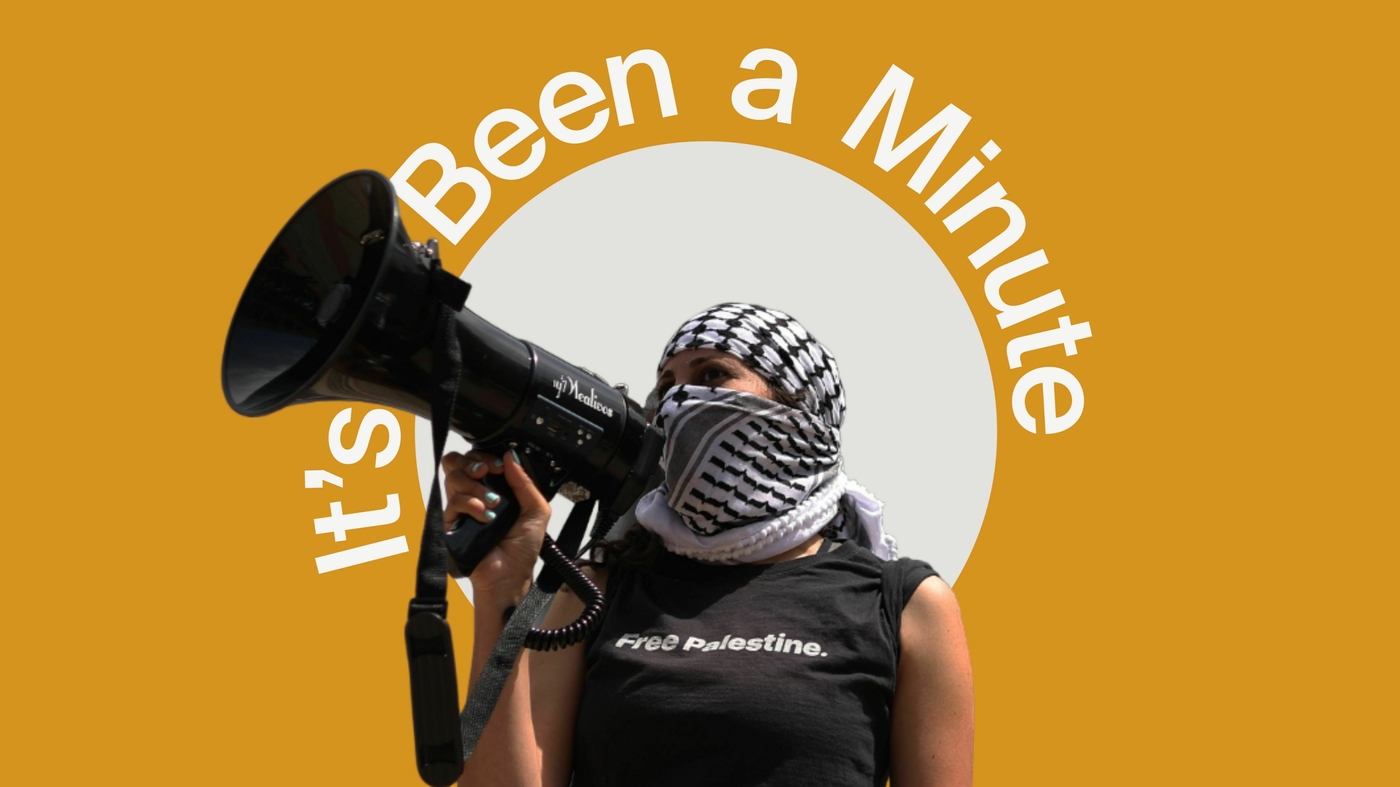
 Lifestyle1 day ago
Lifestyle1 day agoIs the free speech debate dead? Plus, the devil! : It's Been a Minute













